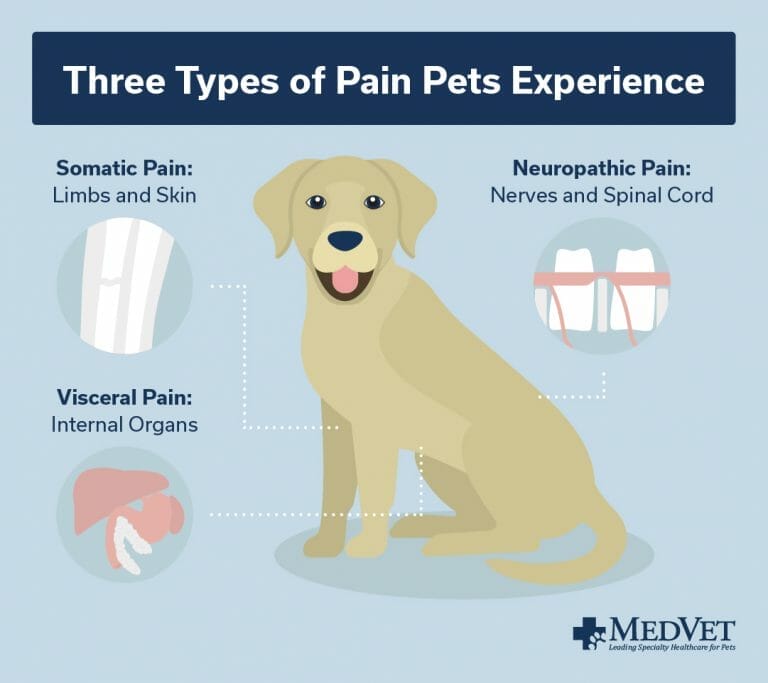How to Tell If Your Pet Is in Pain and What You Can Do to Help
Animals feel pain just like humans, and they can’t let us know when or where they hurt. Learn what to look for and how you can help.
Animals feel pain for many of the same reasons as people: dental issues, arthritis, infections, broken bones, cancer, post-surgical pain, strains/sprains, back problems, stomach upset, constipation, urinary tract infections, and as a result of other injuries and illness. Unfortunately, unlike us, they are not able to let us know when or where they hurt. Many subtle behavioral and physical changes can indicate that your pet is in pain. As a pet parent, you are in the best position to look for these subtle changes that may indicate if your pet is in pain. Here are some clinical signs indicating your pet may be experiencing pain.
Signs Your Dog May be in Pain
Dogs can show pain in a variety of ways. Some of these signs are more obvious like whining or whimpering while others are barely noticeable and more difficult to detect. Additionally, not all dogs express pain in the same way. For example, younger puppies and older dogs may not express their pain as clearly as other animals. There are also certain dog breeds that appear more sensitive to painful stimuli while others are very stoic. Signs may include:
- Change in Activity Level: restless, reluctant to move, difficulty getting up from a laying position, repetitively gets up and lies down, trembling, circling, lying very still, seeks more affection than usual, hides, walking slower or refusing to walk, or showing reluctance to jump or use stairs
- Unusual Behavior
- Aggressive: growls or bites, pins ears back, especially a previously friendly dog
- Daily Habits: withdrawn, changes in sleeping or eating/drinking habits, accidents in the house
- Vocalizing: whining, whimpering, yelping, groaning, grunting
- Altered body positions or movements:
- Facial Expression: grimaces, vacant or glazed stare, wide-eyed, enlarged pupils, flattened ears, pants excessively when at rest
- Posture: hunched with hindquarters raised and front end lying down on the ground, lays on its side
- Self-Protection: protects a body part, doesn’t put weight on a limb or has a limp, doesn’t want to be held or picked up
- Change in self-care:
- Grooming: coat lacks normal shine or hair stands up in places
- Self-Mutilation: licking, biting, or scratching a particular part of the body
Signs Your Cat May Be in Pain
Cats most certainly are different than dogs, and they are more likely to hide their pain. For that reason, spotting signs of pain in cats can be more challenging. It is important not to look at a cat’s actual behavior, but rather at any changes in their behavior that may indicate pain. For example, inappropriate toileting, aggression, anxiety, and seemingly uncharacteristic or bizarre behavior may all have pain as an underlying cause. Signs may include:
- Change in Activity Level: restless, reluctant to move, slow to get up from a laying position, repetitively gets up and lies down, trembles or shakes, limps, can’t jump as high, seeks more affection, avoids being petted or handled, hides
- Unusual Behavior
- Aggressive: growls, hisses, bites, pins ears back, especially a previously friendly cat
- Daily Habits: withdrawn, changes in sleeping or eating/drinking habits, accidents outside litterbox, frequent urination
- Vocalizing: meowing, purring, hissing, growling
- Altered Body Positions or Movements
- Facial Expression: grimaces, furrowed brow, vacant or glazed stare, wide-eyed, enlarged pupils, flattened ears, pants when at rest Posture: lays with feet underneath, arches back or tucks in abdomen
- Self-Protection: protects a body part, doesn’t put weight on a limb or limps, doesn’t want to be held or picked up
- Change in Self-Care
- Grooming: grooms less, unkempt appearance
- Self-Mutilation: licking, biting, or scratching a particular part of the body
Do Animals Show Pain the Same?
Every animal is different, and it is difficult to generalize pain symptoms. Likewise, their responses to surgery, injury, and therapy are unique. Just like with humans, individuals may experience and express pain differently, even if they are undergoing the same procedure or experiencing the same condition. In addition, an individual animal can experience more than one type of pain at any given time.
Types of Pain Pets Experience
There are generally three types of pain based on where your pet feels pain in the body. These can be felt at the same time or at different times, depending on the type of injury, illness, or condition. These different types of pain respond differently to the various pain medications and therapies available.
- Somatic pain is felt in the limbs and skin. Broken bones, surgical pain, bumps, and bruises are examples of somatic pain.
- Visceral pain is focused on internal organs. Some examples of visceral pain include an intestinal blockage, urinary stones, or pancreatitis.
- Neuropathic pain is pain stemming from nerves and the spinal cord. This can include nerve damage, some cancers, a slipped disc, phantom limb pain, or peripheral neuropathy.

Pain is further classified as either acute or chronic.
- Acute pain comes from something that just happened such as an injury or illness. Acute pain is usually easier to identify the cause, is shorter lasting, and usually resolves with time and treatment.
- Chronic pain is defined as pain lasting more than three months such as pain from osteoarthritis. Unfortunately, chronic pain is not as easy to classify and will never completely go away. However, it can be managed to keep your pet comfortable and living their best life.
How You Can Help a Pet in Pain
If you suspect your pet is in pain, an important first step in helping alleviate it is to make an appointment with your veterinarian to determine the cause. Additionally, it is important to:
- Keep a record of the signs you’re seeing. Sometimes you may see certain signs at home but by the time you take your pet to the veterinarian “everything looks fine.” Keep a written log, take a picture, or take a video. These records can be helpful to your veterinarian.
- Follow the veterinarian’s instructions. After examination by a veterinarian, please follow all instructions for treatment. If your pet is prescribed medication, it is important to give it as instructed. Additionally, your veterinarian may want to run diagnostic tests to pinpoint the problem such as radiographs, blood tests, or an ultrasound. Depending on the outcome of these tests, more advanced diagnostic tests such as an MRI may be recommended. The additional information gained through these tests contributes to a better understanding of why your pet’s experiencing pain. Better understanding allows for more customized therapy and supports a better outcome, too.
- Don’t be afraid to ask questions or get a second opinion. It’s okay if you are feeling unsure, want another opinion, would like to see a specialist, or want different treatment options. Communicate this with your veterinarian and he or she can refer you to the proper clinic.
- Explore treatment options. There are many treatment options depending on the cause of the pain. They may include: medications, supplements/herbal therapies, surgery, physical rehabilitation, cold laser therapy, acupuncture, cold/heat therapy, massage. Veterinarians often use multi-modal pain management which is a combination of modalities to treat pain.

What Not to Do for a Pet in Pain
It is very concerning to see your pet in pain, and it can be tempting to provide quick relief. However, some actions can cause greater health challenges for your pet.
- Never administer pain medication to a pet without consulting a veterinarian. Many human pain relievers, such as ibuprofen or acetaminophen, are poisonous and can be fatal.
- Do not change the frequency of medication unless directed by your veterinarian.
- Do not give any other drug or supplement to your pet while it is taking prescribed medications without first consulting your veterinarian or veterinary specialist.
- Use caution when moving a painful pet to prevent injury to yourself and your pet.
Your Pet is Counting on You
Your pet depends on you to be their voice and get them the help they need. If you think your pet is in pain and your family veterinarian is unavailable, contact your nearest MedVet or an emergency veterinary clinic.
FAQs
Learn More
For ways to ensure your pet lives a happier, healthier life, visit our Pet Care Resources library.
Pet Care ResourcesContents
Learn More
For ways to ensure your pet lives a happier, healthier life, visit our Pet Care Resources library.
Pet Care Resources

